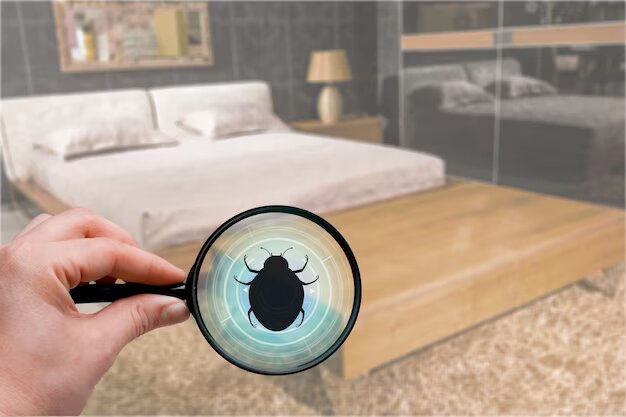
So, you’ve woken up feeling something isn’t quite right, and your heart sinks as you turn on the lights. Your once serene bedroom is now the battleground against an unwelcome invasion – bed bugs. These tiny, stealthy pests have turned your haven into a nightmare.
But fear not! The journey to reclaim your peaceful slumber from these unwelcome guests is challenging but achievable. Arm yourself with knowledge and the right strategies to regain control and ensure these pesky invaders are sent packing.
Understanding Your Enemy: Identifying Bed Bugs
The first step in any battle is knowing your enemy. Bed bugs are elusive, nocturnal insects feeding on human blood. They’re about the size of an apple seed, reddish-brown, and flat. Recognizing these pests and their common hiding spots—mattress seams, bed frames, and behind wallpapers—is essential to formulating an effective battle plan.
Early Detection: Signs Of Bed Bug Presence

Be vigilant for signs like tiny blood stains on your sheets, small dark spots of bug feces, and a distinctive, sweet, musty odor. Spotting these indicators can prevent a full-blown infestation.
Home Remedies And Over-The-Counter Solutions
In the initial stages of an infestation, you can try several do-it-yourself methods. Home remedies like diatomaceous earth can be effective in dehydrating bed bugs. Over-the-counter sprays may also offer a temporary solution. However, these methods may not always be successful.
Cleaning Rituals: Vacuuming And Decluttering
Integral to your anti-bed bug strategy is maintaining a clean and clutter-free space. Vacuuming regularly can suck up wandering bed bugs and their eggs. Decluttering your space eliminates their potential hiding spots, making it harder for them to thrive and multiply.
Heat Treatment: Your Secret Weapons

Bed bugs are vulnerable to high temperatures. Washing your bedding, curtains, and clothing at temperatures above 120°F can kill these pests. Similarly, using a steamer on your mattress and other furniture can effectively exterminate these pests without chemicals.
Sealing Entry Points: Preventing Future Infestations
Preventing future infestations is as crucial as tackling the current one. Inspect and seal any cracks and crevices in walls, baseboards, and furniture. This blocks potential entry points for bed bugs and their escape routes.
Exterminators: When To Call In The Experts
When the infestation goes beyond the scope of DIY methods, it’s time to call in professional exterminator services. These experts have the experience, tools, and techniques to deal with bed bugs more effectively and efficiently. While this option can be more costly, it often offers a more permanent solution to severe infestations.
Chemical Treatments: Pros And Cons
Professional exterminators typically use chemical treatments to eradicate bed bugs because it’s considered the most effective way. However, these methods can come with their pros, such as the need to vacate your home temporarily and potential health risks.
Here are three examples of chemical treatments commonly used by professional exterminators for bed bug eradication, along with their respective pros and cons:
Pyrethroids And Pyrethrins
- Pros: These synthetic chemical insecticides mimic the natural insecticidal properties of chrysanthemum flowers. They are widely used because they are generally effective against bed bugs and have a quick knockdown effect. They are also available in various formulations, allowing for flexible application methods.
- Cons: Bed bugs have increasingly resisted these chemicals, reducing their effectiveness in some cases. Additionally, pyrethroids and pyrethrins can be toxic to pets and humans if not used correctly, and prolonged exposure can lead to health issues.
Neonicotinoids
- Pros: Neonicotinoids are a newer class of insecticides that work on the nervous system of bed bugs, causing paralysis and death. They are effective even against strains of bed bugs that have developed resistance to older insecticides. These chemicals have a prolonged residual effect, so they continue to kill bed bugs after the initial application.
- Cons: The primary concern with neonicotinoids is their potential environmental impact, particularly on pollinators like bees. There are also health concerns if not applied correctly, necessitating the need for professional handling and application.
Insect Growth Regulators (IGRs)
- Pros: IGRs work by mimicking or interfering with the hormones that regulate bed bug growth and development. This results in disrupted life cycles, preventing bed bugs from reaching maturity or reproducing effectively. IGRs are a long-term solution and are considered less toxic than other insecticides, making them safer for residential areas.
- Cons: The effectiveness of IGRs is not immediate, as they target the developmental stages of bed bugs. Therefore, they are often combined with other insecticides for a more immediate effect. Additionally, IGRs may require multiple applications over time.
Non-Chemical Treatments: Alternative Options

Professional heat treatments, where the entire room is heated to a temperature lethal to bed bugs, and cryoconite treatments, which use extreme cold, are environmentally friendly options. While often effective, these methods can be costly and require specialized equipment.
2 Examples Of Non-Chemical Treatments Used To Combat Bed Bugs:
- Heat Chambers: This approach utilizes portable heat chambers to place infested items such as clothing, bedding, and small furniture. The chamber then raises the temperature to a level that is lethal to bed bugs but safe for most household items. This method is particularly useful for treating belongings like books, which cannot be easily treated.
- Silica Gel Desiccants: Silica gel can dehydrate bed bugs. They are often found in small packets to keep products dry. When applied to areas where bed bugs are present, the fine particles of silica gel attach to the bugs’ bodies, absorbing the fats and moisture, leading to dehydration and death.
Ongoing Vigilance: Maintaining A Bed Bug-Free Home
Winning the battle against bed bugs is just the beginning. Maintaining a bed bug-free home requires continuous vigilance. Regular inspections, preventive measures, and immediate action at the first sign of a resurgence are crucial to keeping these pests at bay.
Conclusion
The journey of battling bed bugs is undoubtedly daunting, but with the right strategies and a proactive approach, it is a battle that can be won. Each step is crucial in reclaiming your space, from early detection to employing professional services. Remember, overcoming a bed bug infestation isn’t just about the immediate battle; it’s about ensuring a long-term, peaceful, and bug-free environment. With determination, patience, and the right tactics, you can send these unwelcome guests packing and restoring tranquility to your home.
Read Also:




























